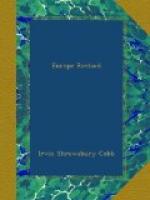I think of one experience I had while touring through what we had learned to call the Dachshund District. Our route led us alongside a most inconsequential-looking little river. Its contents seemed a trifle too liquid for mud and a trifle too solid for water. On the nearer bank was a small village populated by short people and long dogs. Out in midstream, making poor headway against the semi-gelid current, was a little flutter-tailed steamboat panting and puffing violently and kicking up a lather of lacy spray with its wheelbuckets in a manner to remind you of a very warm small lady fanning herself with a very large gauze fan, and only getting hotter at the job.
In America that stream would have been known as Mink Creek or Cassidy’s Run, or by some equally poetic title; but when I found out it was the Danube—no less—I had a distinct thrill. On closer examination I discovered it to be a counterfeit thrill; but nevertheless, I had it.
What applies in the main to the scenery applies in the main to the food. France has the reputation of breeding the best cooks in the world—and maybe she does; but when you are calling in France you find most of them out. They have emigrated to America, where a French chef gets more money in one year for exercising his art —and gets it easier—than he could get in ten years at home—and is given better ingredients to cook with than he ever had at home.
The hotel in Paris at which we stopped served good enough meals, all of them centering, of course, round the inevitable poulet roti; but it took the staff an everlastingly long time to bring the food to you. If you grew reckless and ordered anything that was not on the bill it upset the entire establishment; and before they calmed down and relayed it in to you it was time for the next meal. Still, I must say we did not mind the waiting; near at hand a fascinating spectacle was invariably on exhibition.
At the next table sat an Italian countess. Anyhow they told me she was an Italian countess, and she wore jewelry enough for a dozen countesses. Every time I beheld her, with a big emerald earring gleaming at either side of her head, I thought of a Lenox Avenue local in the New York Subway. However, it was not so much her jewelry that proved such a fascinating sight as it was her pleasing habit of fetching out a gold-mounted toothpick and exploring the most remote and intricate dental recesses of herself in full view of the entire dining room, meanwhile making a noise like somebody sicking a dog on.
The Europeans have developed public toothpicking beyond anything we know. They make an outdoor pastime and function of it, whereas we pursue this sport more or less privately. Over there, a toothpick is a family heirloom and is handed down from one generation to another, and is operated in company ostentatiously. In its use some Europeans are absolutely gifted. But then we beat the world at open-air gum-chewing—so I reckon the honors are about even.




